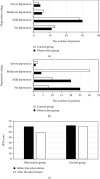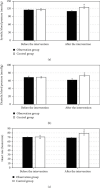Therapeutic Effect of Ultrasound-Guided Peripherally Inserted Central Catheter Combined with Predictive Nursing in Patients with Large-Area Severe Burns
- PMID: 35959348
- PMCID: PMC9357783
- DOI: 10.1155/2022/1019829
Therapeutic Effect of Ultrasound-Guided Peripherally Inserted Central Catheter Combined with Predictive Nursing in Patients with Large-Area Severe Burns
Abstract
This study was aimed to explore the application value of ultrasound-guided peripherally inserted central catheter (PICC) combined with predictive nursing in the treatment of large-area severe burns. 88 patients with large-area severe burns who visited hospital were chosen as the research objects. They were randomly divided into the observation group and the control group, with 44 cases in each. The patients in the observation group were treated with ultrasound-guided PICC combined with predictive nursing, while those in the control group were treated with traditional PICC and nursing methods. Then, the anxiety of patients was compared between groups by the Self-rating Anxiety Scale (SAS), while the depression was compared by the Self-rating Depression Scale (SDS). The pain of the patients was analyzed by the McGill Pain Questionnaire (MPQ), and a self-made nursing satisfaction questionnaire was adopted to evaluate the nursing satisfaction. The surgery-related indicators of the patients were detected and recorded (the success rate of one-time puncture, the success rate of one-time catheter placement, incidence of complications, heart rate, blood pressure, etc.). The success rates of one-time puncture (93% vs. 86%) and of catheter placement (95% vs. 81%) in the observation group were significantly higher than those in the control group, P < 0.05. The pain scores of the observation group were much lower than those of the control group at each time period, P < 0.05. The number of patients with negative emotions such as anxiety and depression in the observation group was markedly less than that in the control group. The incidence of complications in the observation group was notably lower than that in the control group (4.5% vs 18%), P < 0.05. The nursing satisfaction of the observation group was significantly higher than that of the control group (93% vs 79.5%), P < 0.05. In conclusion, ultrasound-guided PICC and predictive nursing had high clinical application values in the treatment of patients with large-area severe burns.
Copyright © 2022 Baiyan He et al.
Conflict of interest statement
The authors declare no conflicts of interest.
Figures







Similar articles
-
Safety and feasibility of ultrasound-guided placement of peripherally inserted central catheter performed by neurointensivist in neurosurgery intensive care unit.PLoS One. 2019 May 31;14(5):e0217641. doi: 10.1371/journal.pone.0217641. eCollection 2019. PLoS One. 2019. PMID: 31150465 Free PMC article.
-
Comparison on clinical efficacy and adverse reactions between TPICC and ultrasound-guided PICC for advanced tumors: A retrospective study.Medicine (Baltimore). 2024 Oct 18;103(42):e38130. doi: 10.1097/MD.0000000000038130. Medicine (Baltimore). 2024. PMID: 39432615 Free PMC article.
-
A randomised, controlled trial comparing the long-term effects of peripherally inserted central catheter placement in chemotherapy patients using B-mode ultrasound with modified Seldinger technique versus blind puncture.Eur J Oncol Nurs. 2014 Feb;18(1):94-103. doi: 10.1016/j.ejon.2013.08.003. Epub 2013 Sep 7. Eur J Oncol Nurs. 2014. PMID: 24018351 Clinical Trial.
-
Real-time ultrasound-guided placement of peripherally inserted central venous catheter without fluoroscopy.J Vasc Access. 2018 Nov;19(6):609-614. doi: 10.1177/1129729818765057. Epub 2018 Mar 21. J Vasc Access. 2018. PMID: 29562841
-
Effect of multidisciplinary cooperative continuous nursing and psychological nursing on multiple myeloma with a peripherally inserted central catheter.Future Oncol. 2024 Mar;20(8):471-479. doi: 10.2217/fon-2023-0757. Epub 2024 Mar 14. Future Oncol. 2024. PMID: 38482686
Cited by
-
A retrospective two-center cohort study on the use of routine chest X-ray after peripherally inserted central catheter placement under ultrasound and intracavitary electrocardiography guidance.Ann Transl Med. 2022 Dec;10(24):1315. doi: 10.21037/atm-22-5417. Ann Transl Med. 2022. PMID: 36660617 Free PMC article.
References
-
- Galen B., Baron S., Young S., Hall A., Berger-Spivack L., Southern W. Reducing peripherally inserted central catheters and midline catheters by training nurses in ultrasound-guided peripheral intravenous catheter placement. BMJ Quality and Safety . 2020;29(3):245–249. doi: 10.1136/bmjqs-2019-009923. - DOI - PubMed
-
- Choi K., Keum M. A., Kim M. S., et al. Feasibility of the ultrasound-guided insertion of the peripherally inserted central catheter (PICC) by the vascular surgeon at the bedside in the trauma intensive care unit. Annals of Vascular Surgery . 2022;80:143–151. doi: 10.1016/j.avsg.2021.08.038. - DOI - PubMed
Publication types
MeSH terms
LinkOut - more resources
Full Text Sources
Medical

